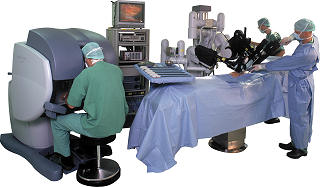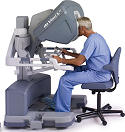Robotic Surgery
Introduction
Robotic surgery is an advancement of laparoscopic “keyhole” surgery, which has been developed over the last few years. Normal keyhole surgery enables the trained surgeon to access organs within the body such as the kidney and prostate using long hand-held instruments to operate within the body with very small incisions. This type of surgery has proved very successful over the last 20 years and led to excellent outcomes in term of cancer removal and patient recovery.
The da Vinci® Surgical System (Intuitive Surgical, Inc.) enhances laparoscopic surgical capabilities by providing the surgeon with the ability to operate at a high magnification (10-15x) with great precision allowing micro dissection within the body. EndoWrist® instruments allow full wrist movements at this microscopic level which is not possible with normal laparoscopic surgery. The da Vinci® robotic system is now well recognised as a step forward in the treatment of surgical patients across a wide spectrum of specialities, including urology.
Mr Thilagarajah has been Clinical Lead of Robotic Services at Mid Essex Health Services NHS Trust since 2008. He is one of a small number of proctor trainers in kidney robotic surgery in the UK preforming a large number of specialist kidney operations for both NHS and private patients.
Comparison of surgical techniques
| Traditional Open Surgery | Laparoscopic Surgery | Robotic Assisted Laparoscopic Surgery | |
| Short Hospital Stay |  |  |  |
| 10-15x Micro Dissection |  |  |  |
| 3 D Vision |  |  |  |
| Surgeon Comfort |  |  |  |
| Fewer Blood Transfusions |  |  |  |
| Less Risk of Infection |  |  |  |
| Faster Recovery |  |  |  |
| Less Pain and Scarring |  |  |  |
| Rapid Return to Normal Activities |  |  |  |
Robotic surgery set up

- The patient is prepared as for routine laparoscopic “keyhole” surgery
- The operation is started as per laparoscopic surgery with small incisions made and the access ports put in
- The robot unit is wheeled to the operating table and the robotic arms are connected to the access ports and stabilised
- The robotic laparoscopic instruments are inserted connected to the robot arms and introduced into the body via the ports
- The surgeon sits at the separate operator console and uses finger tip controls to manoeuvre the instruments within the body whilst watching on the High Definition 3-D video monitor which gives a real time view of the body cavity of the pativ

